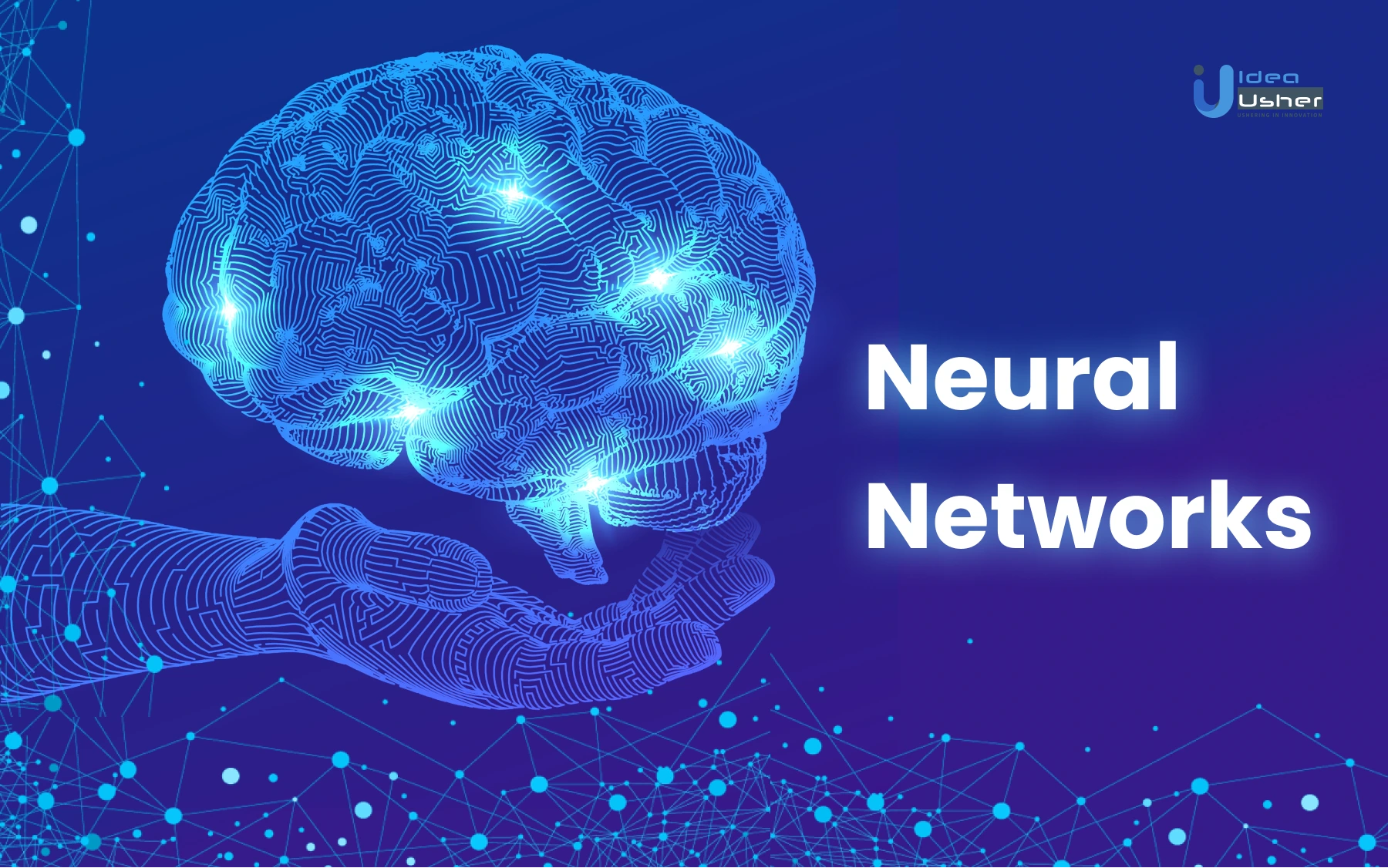
Artificial intelligence (AI) and machine learning (ML) have become the talk of the technological town. They’ve found their increased use in several industries such as finance, health, entertainment, and more. These technologies can mimic human behavior with the help of algorithms known as Artificial Neural Networks (ANN).
The global ANN market size is predicted to reach USD 325 million by 2025.
Adroit Market Research
This blog discusses ANNs, their types, use cases, and more.
What are artificial neural networks?
Artificial Neural Networks (ANN), simply known as neural networks, are a subset of machine learning and are at the core of deep learning algorithms. These networks are inspired by the human brain and send signals to one another like biological neurons.
ANNs use interconnected nodes or neurons to analyze complex data and find patterns and trends which are too complicated for the human brain or other computer techniques. These networks depend on training data to learn and improve their accuracy. However, once trained, they learn on their own.
The accuracy and speed of ANNs have enabled us to classify and cluster data in minutes as against hours taken by human experts. As a result, these networks are being used in several AI solutions. A famous example is Google’s search algorithm which predicts what the user wants to type based on their past activity and the existing search query.
Understanding the ANN architecture
Before discussing the functioning of ANNs, it is essential to understand their architecture. As stated earlier, an ANN is inspired by biological neural networks. The human brain consists of multiple brain cells called neurons, which send electric signals to help process information. Similarly, an ANN is composed of artificial neurons, called nodes, that work together to solve a problem.
These nodes are present in several layers. Each layer serves a different purpose, and the higher the complexity of the network, the more layers in the network.
A typical ANN consists of the following layers:
1. Input layer
The input layer is the entry point for the data from the outside world into the ANN. The input nodes present in this layer process, analyze, or categorize it before forwarding it to the next layer.
2. Hidden layer
The hidden layers are responsible for the back-end tasks like calculations and processing. There can be one or more hidden layers present in a network. These layers take their input from the input layer or other hidden layers, analyze and process the same, and pass it on to the next layer.
3. Output layer
The output layer is the final layer that provides the result of all the data processed by the ANN. This layer can constitute single or multiple nodes depending on the classification problem.
How does ANN work?
Here is how the data is processed and transmitted through the various layers in an ANN:
- Each node in the layers comprises input data, weights, a threshold, and an output.
- Weights are assigned after the determination of the input layer. These weights determine the importance of the input variables. Input variables with higher weight contribute more to the output than other inputs.
- The product of the inputs and their respective weights are added. The data then passes through an activation function, which decides the output.
- If the output exceeds the threshold, it activates the node and passes the data to the next layer. Thus, one node’s output becomes the other’s input.
This method of data transmission is called forward propagation since data is passed from one layer to the next throughout this procedure. However, you can also train the network to work in the opposite direction, i.e., from output to input. This process is called backpropagation. We can calculate and trace the error linked to each neuron via backpropagation, which enables us to alter and fit the model’s parameters suitably.
Types of ANN
There are various types of ANNs that serve different purposes.
Broadly the following are the major types of ANNs that have been used in multiple fields:
1. Feedforward neural networks
These networks transmit the data only in one direction, i.e., forward. These networks are also called multi-layer perceptrons (MLP). Each node in a layer is connected to every node in the next layer in this network. The input node transmits the data to the output node. We need to feed the data to train the feedforward neural network, and the network uses a feedback process to improve prediction accuracy.
2. Convolutional neural networks (CNN)
CNNs are a type of ANN used to analyze visual imagery. They are extensively used for image recognition and classification, pattern recognition, text digitization, natural language processing, etc. These networks contain one or more convolutional layers that perform mathematical functions like summarizing or filtering, called convolutions.
3. Recurrent neural networks (RNN)
RNNs are a type of ANN with a unique characteristic called feedback loops. They utilize their ‘memory’ and extract information from the prior inputs to influence the current input and output, unlike other networks that consider input and output independent. These networks are mainly employed to make predictions using time-series data, like sales forecasting.
What are deep neural networks (DNN)?
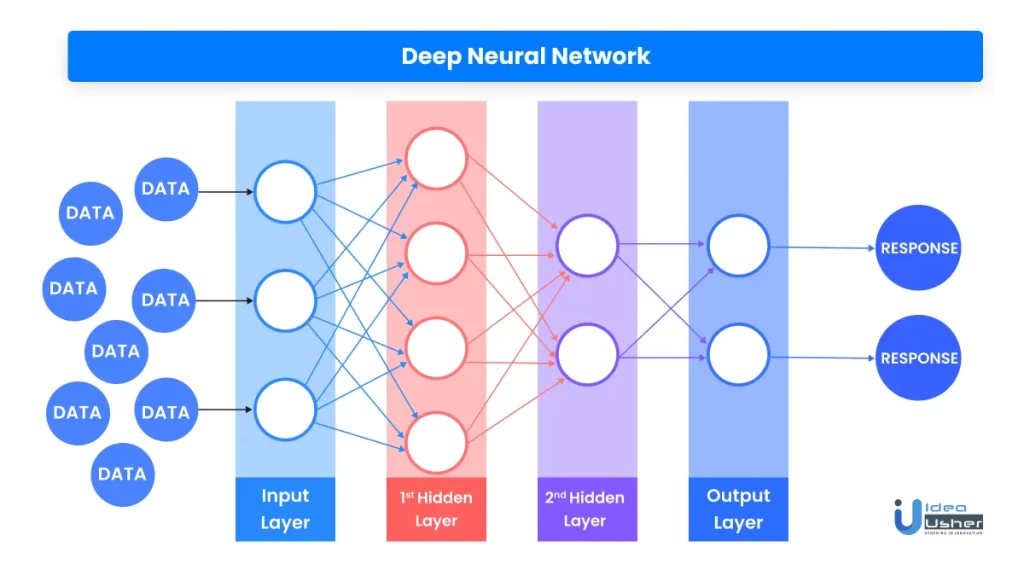
Simply put, when an ANN consists of more than one hidden layer, it is considered a DNN. DNNs are at the heart of Deep Learning. Deep learning is a field within machine learning that aims to solve complex problems using algorithms that mimic the human brain and do not require explicit programming.
Applications of DNN
Since the DNN is simply an ANN with multiple hidden layers, the applications of the two networks often overlap. Here are a few applications of DNN:
1. Aerospace
DNNs have varied uses in the aerospace industry. They are used for fault detection, auto-piloting, path simulation, etc.
2. Social media
Intelligent recommendations and personalized social media feeds are applications of DNNs. For example, the ‘People you may know’ section on Facebook results from an analysis of your interests, past activity, friends list, etc.
3. E-commerce
Almost all e-commerce platforms recommend products and personalize the user’s feed based on past purchases, likes, dislikes, etc. DNNs aid in this process.
4. Finance
Gone are the days when financial risks were almost impossible to predict. With the advent of neural networks, stock market forecasting has become more accurate. DNNs help in corporate financial analysis, market analysis, automatic bond rating, etc.
5. Business analytics
Businesses benefit a lot from DNNs. These networks aid in customer segmentation, fraud propensity, market research, customer behavior modeling, etc.
6. Weather forecasting
Weather forecasts help predict the upcoming weather conditions. Earlier, these forecasts were not as accurate as they are now. DNNs also enable forecasters to predict impending natural disasters.
A detailed understanding of CNN
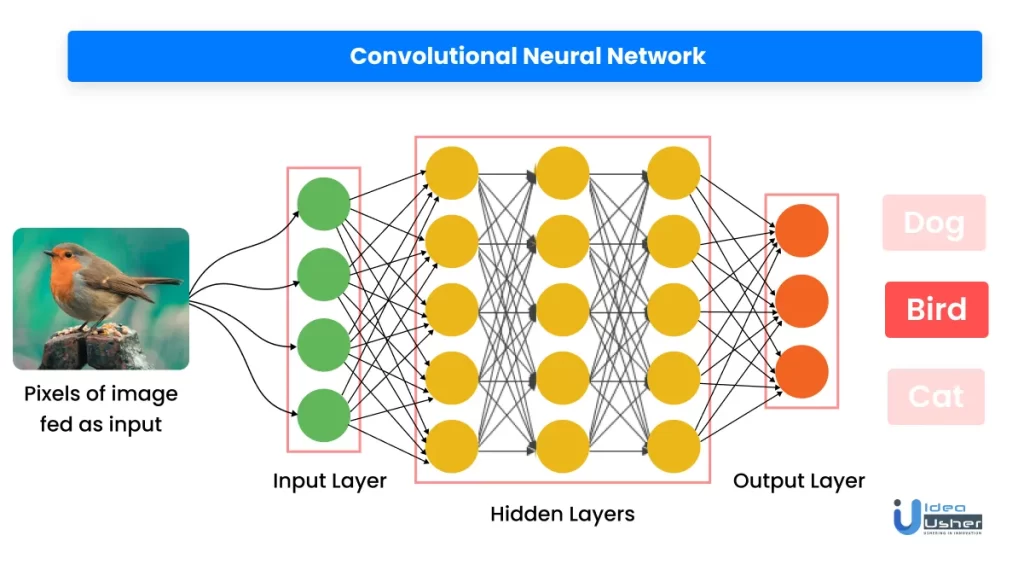
As described earlier, CNNs are a type of ANN that help in computer vision tasks. Before CNN, object identification in images was a manual, time-consuming and tiring activity. However, CNN is a scalable approach to image classification and object identification as it utilizes linear algebra principles to identify patterns within an image.
A CNN has the following layers:
- Convolutional Layer: The convolution layer is the first layer in a CNN, where the significant computation occurs. It requires inputs, a filter, and a feature map. The filters are run through the inputs to check if a feature is present. This process is called convolution.
- Pooling Layer: Downsampling occurs in the pooling layer. This layer reduces the number of parameters in the input. Similar to the convolutional layer, a filter is applied to the image but does not have any weight.
- Fully-connected Layer: This is the final layer in a CNN. It performs classification based on the features extracted in the previous layers and generates the final output.
Types of CNN architectures
- LeNet
- AlexNet
- VGGNet
- ResNet
- GoogLeNet
- ZFNet
Applications of CNN
1. Cancer detection
We can detect cancer in CT scans and other medical images using CNN. They take the patient’s scanned image and compare it to the images in the database to identify damaged cells due to genetics or environmental factors such as smoking.
2. Facial recognition
CNN takes an image as input and performs operations to identify facial features in the picture. It can locate the eyes, nose, mouth, etc., despite external factors such as light, angle, pose, etc. It also compares the given data to existing data to match a face with a name.
3. Self-driving cars
Autonomous vehicles employ CNN to identify obstacles or interpret street signs for a smooth traffic flow.
4. Handwriting recognition
CNN is used to recognize characters in handwriting. It takes the handwriting image as input and breaks it into smaller parts to identify characters. It can also detect handwriting in multiple languages.
5. Biometric authentication
CNN has been widely used for biometric authentication as it can identify the physical characteristics of a person’s face. It can detect the distance between the eyes, lip curvature, etc., to authenticate a person’s identity. Also, it is able to analyze the face in different emotions.
What are region-based convolutional neural networks (R-CNN)?
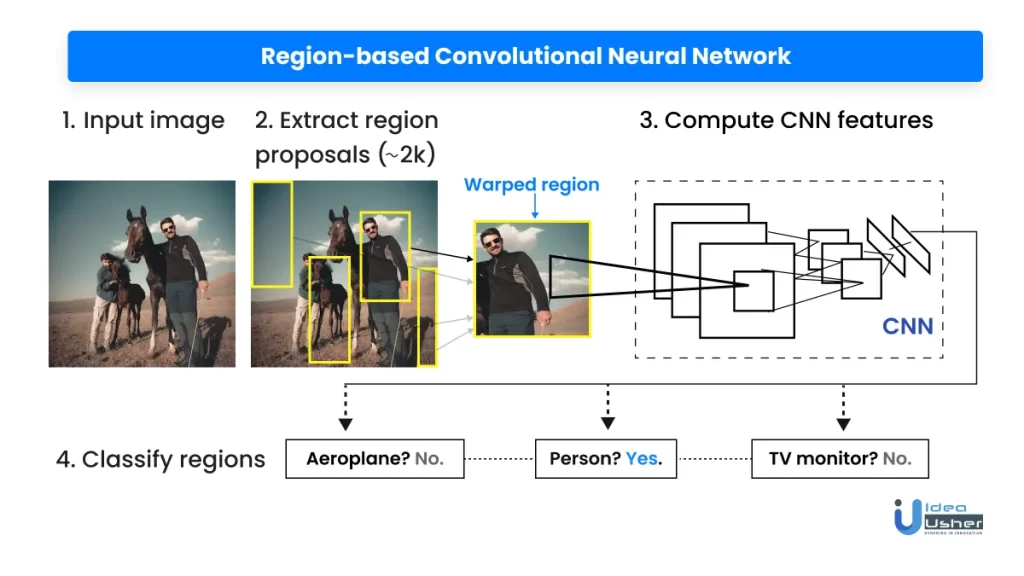
The CNN focuses on applying the filters to the image input and generating output. For object detection in CNN, you must create a bounding box around the object of interest. A thing to note here is that you will have to create multiple bounding boxes to locate different regions in the image, leading to computational complexity.
Region-based convolutional neural networks (R-CNN) solves this problem of selecting a large number of regions. In the R-CNN model, the input image goes through a selective search, and 2000 regions are extracted from the image. These regions are called region proposals. So, instead of focusing on the entire image, R-CNN forces the CNN to focus on a particular region, improving the dominance of a specific object in that region.
Versions of R-CNN
- Fast R-CNN: In Fast R-CNN, you do not have to feed in 2000 region proposals every time. Instead, the convolution function is applied to the entire image at once to generate a feature map.
- Faster R-CNN: Both the R-CNN and the Fast R-CNN used selective search to generate ROIs, which is time-consuming. Faster R-CNN eliminates the selective search and integrates the ROI generation into the network itself.
- Mask R-CNN: Mask R-CNN introduces instance segmentation in the object detection process. Instance segmentation correctly detects all objects and precisely segments each instance.
- Mesh R-CNN: Mesh R-CNN detects the objects from the input image and generates their 3D shape.
Applications of R-CNN
1. Drone-mounted camera
Drone-mounted cameras use Faster R-CNN to detect and trace objects from a distance.
2. Text location in images
Faster R-CNN enables the identification of text within an image. For example, when a user puts in a particular search query, the network analyzes the images and identifies if the searched text is present in the picture.
3. Object detection in Google Lens
Google Lens uses Fast R-CNN to detect objects using the phone camera. The model is used primarily for text detection.
DNN vs. CNN vs. R-CNN: A comparison
Here is a brief comparison between the three major networks that we discussed above:
| DNN | CNN | R-CNN | |
| Meaning | A type of ANN that receives a set of inputs, performs progressively complex calculations on them, and gives output to solve real-world problems using more than one hidden layer. | A network that analyzes visual imagery and converts it to a set of class probabilities. | A network forcing CNN to focus on a single region, improving the dominance of a specific object in that region. |
| Types/ Versions | 1. MLP 2. CNN 3. RNN | 1. LeNet 2. AlexNet 3. VGGNet 4. GoogLeNet 5. ResNet | 1. Fast R-CNN 2. Faster R-CNN 3. Mask R-CNN 4. Mesh R-CNN |
| Used for | Data processing and prediction | Visual analysis | Regional object detection |
| Layers | 1. Visible/input layer 2. Two or more hidden layers 3. Output layer | 1. Convolutional layer 2. Pooling layer 3. Fully connected layer | 1. Input layer 2. CNN module 3. RNN module 4. Output module |
| Applications | 1. Housing price prediction 2. Weather prediction 3. Image classification 4. Machine translation | 1. Cancer detection 2. Biometric authentication 3. Image captioning 4. Document summarization | 1. Tracking objects from a drone-mounted camera 2. Locating text in an image 3. Enabling object detection in Google Lens |
All the networks discussed above have diverse use cases and applications. The suitability of any network depends on the purpose for which we wish to employ it.
Winding up
ANNs are a significant component of artificial intelligence and machine learning. Their ability to mimic the human brain and perform complex computations has helped several industries speed up their processes and perform predictions with greater accuracy. The ANNs have already found an array of use cases, and as the technology advances, it would be interesting to witness the other areas where it can be applied.
Idea Usher has been in the business of providing best-in-class AI services for years now. Our industry-leading team of AI developers and professionals delivers custom-made digital solutions. Our diverse range of AI solutions has helped several businesses grow and succeed.
Contact us to take your business a notch higher with our AI services.
E-mail: [email protected]
Phone Numbers : (+91) 946 340 7140, (+91) 859 140 7140 and (+1) 732 962 4560
Frequently asked questions
Here are a few exciting FAQs about artificial neural networks:
1. What have ANNs been used for?
ANNs have various use cases like weather forecasting, face recognition, biometric authentication, stock market prediction, etc.
2. What is the importance of ANNs?
ANNs are critical as they enable machines to perform computations with minimum human intervention. They also improve the speed and the accuracy with which the machines perform the functions.
3. Which is the best ANN?
Each ANN is designed for a different purpose and functions differently. A network’s relevance and importance depend on the activity for which we use it. For instance, a particular ANN may be best for object detection but may not be helpful for fraud detection.





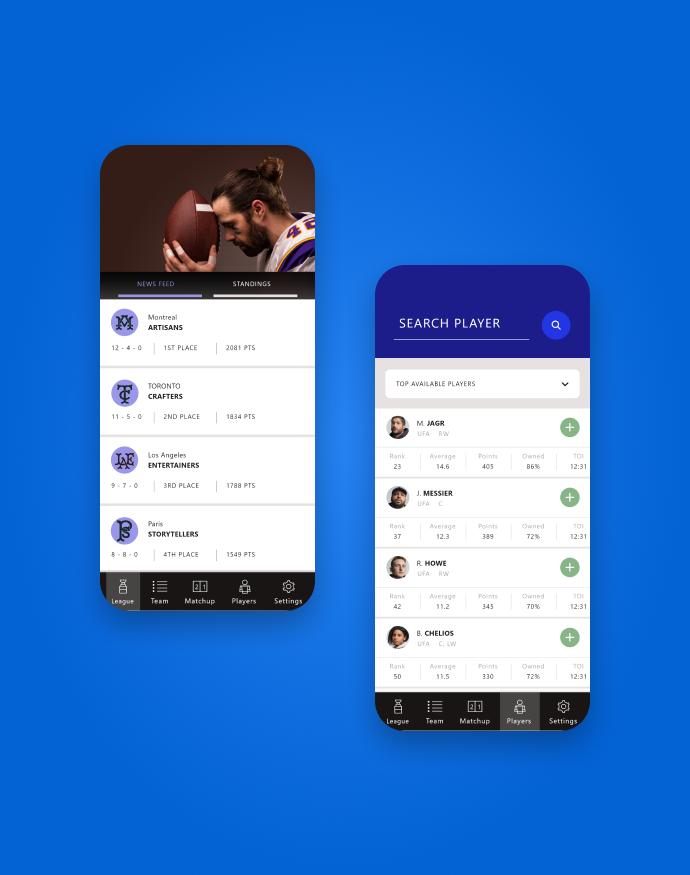



Mayank Sharma